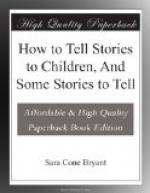Because I believe it to be such, not because I ignore the value of other uses, I venture to push aside all aims which seem secondary to this for later mention under specific heads. Here in the beginning of our consideration I wish to emphasise this element alone. A story is a work of art. Its greatest use to the child is in the everlasting appeal of beauty by which the soul of man is constantly pricked to new hungers, quickened to new perceptions, and so given desire to grow.
The obvious practical bearing of this is that story-telling is first of all an art of entertainment; like the stage, its immediate purpose is the pleasure of the hearer,—his pleasure, not his instruction, first.
Now the story-teller who has given the listening children such pleasure as I mean may or may not have added a fact to the content of their minds; she has inevitably added something to the vital powers of their souls. She has given a wholesome exercise to the emotional muscles of the spirit, has opened up new windows to the imagination, and added some line or colour to the ideal of life and art which is always taking form in the heart of a child. She has, in short, accomplished the one greatest aim of story-telling,—to enlarge and enrich the child’s spiritual experience, and stimulate healthy reaction upon it.
Of course this result cannot be seen and proved as easily and early as can the apprehension of a fact. The most one can hope to recognise is its promise, and this is found in the tokens of that genuine pleasure which is itself the means of accomplishment. It is, then, the signs of right pleasure which the story-teller must look to for her guide, and which it must be her immediate aim to evoke. As for the recognition of the signs,—no one who has ever seen the delight of a real child over a real story can fail to know the signals when given, or flatter himself into belief in them when absent.
Intimately connected with the enjoyment given are two very practically beneficial results which the story-teller may hope to obtain, and at least one of which will be a kind of reward to herself. The first is a relaxation of the tense schoolroom atmosphere, valuable for its refreshing recreative power. The second result, or aim, is not so obvious, but is even more desirable; it is this: story-telling is at once one of the simplest and quickest ways of establishing a happy relation between teacher and children, and one of the most effective methods of forming the habit of fixed attention in the latter.
If you have never seen an indifferent child aroused or a hostile one conquered to affection by a beguiling tale, you can hardly appreciate the truth of the first statement; but nothing is more familiar in the story-teller’s experience. An amusing, but—to me—touching experience recently reaffirmed in my mind this power of the story to establish friendly relations.




